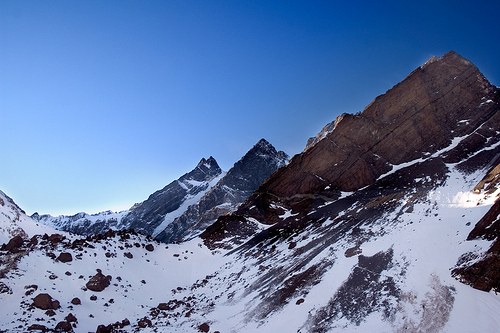The Andes is the world’s longest continental mountain range and the highest outside Asia, with an average elevation of 4000 metres. The question of how quickly the mountains reached such heights has been a contentious one that University of Michigan paleoclimatologist Christopher Poulsen and graduate student Nadja Insel working with Todd Ehlers of the University of Tuebingen in Germany, believe they may now have settled with a new interpretation of isotopic data. Their work suggests that the rise of the Andes was a very gradual process.
Poulsen’s uplifting work suggests that previous interpretations of the evidence have misconstrued changes in oxygen isotope ratios as being due to a rapid rise of the mountain range whereas the more likely explanation is that the changes are due to shifts in ancient climate.
“In the modern climate, there is a well-known inverse relationship between oxygen isotopic values in rain and elevation,” Poulsen explains.
“As a rain cloud ascends a mountain range, it begins to precipitate.
Because atoms of oxygen-18 are more massive than those of oxygen-16, it is preferentially rained out. Thus, as you go up the mountain, the precipitation becomes more and more depleted in oxygen-18, and the ratio of oxygen-18 to oxygen-16 decreases.” Geologists use the ratio of these isotopes, preserved in rock, to infer past elevations and so the rate of rise of a mountain range.
“If the ratio decreases with time, as the samples get younger, the interpretation would typically be that there has been an increase in elevation at that location,” Poulsen adds. He points out that that is the precise conclusion drawn by a series of papers on the uplift history of The Andes published over the past four years. On the basis of oxygen isotope ratios determined by analysis of carbonate rocks, the authors of those papers suggested that the central Andes rose about 2500 to 3500 metres in a mere three million years, Other geologists had assumed that the rise to those heights took place over tens of millions of years.
Unfortunately, elevation is not the only thing to disturb oxygen isotope ratios in precipitation. “It can also be affected by where the vapour came from and how much it rained,” says Poulsen. “More intense rainfall also causes oxygen-18 to be preferentially precipitated.” He and his colleagues were skeptical of the rapid-rise scenario, and so performed climate modelling experiments to investigate whether something other than altitude might have given rise to the shift in ratio observed in carbonate deposits.

“The key result in our modelling study is that we identified an elevation threshold for rainfall,” Poulsen says. “Once The Andes reached an elevation greater than 70 percent of the current elevation, the precipitation rate abruptly increased. In our model, the increased precipitation also caused the ratio of oxygen-18 to oxygen-16 to significantly decrease. Our conclusion, then, is that geologists have misinterpreted the isotopic records in the central Andes. The decrease in the ratio is not recording an abrupt increase in elevation; it is recording an abrupt increase in rainfall.”
This conclusion is backed up by geochemical and sedimentological data, Poulsen said. “There is evidence that the central Andes became less arid at the same time that the isotope records show a decrease in the ratio of oxygen-18 to oxygen-16.”
Links
Christopher Poulsen